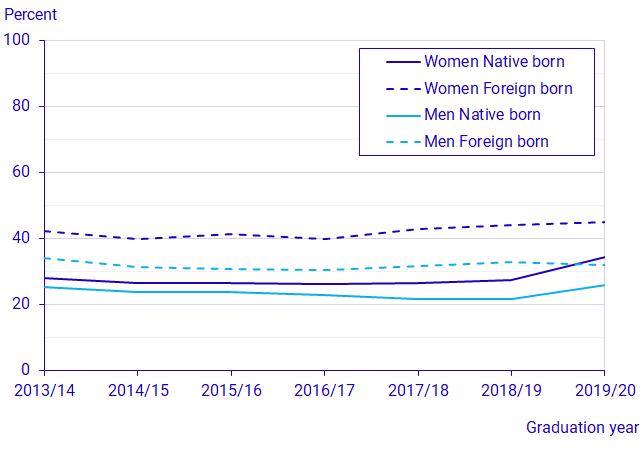Transition upper secondary school – post-secondary education, upper secondary school graduates 2013/14-2019/20
Transitioning to post-secondary education most frequent among foreign born women
Statistical news from Statistics Sweden 2022-05-31 8.00
It is more common among foreign-born pupils to study further after graduating from upper secondary school than among native-born classmates. During the corona pandemic, however, the proportion of native-born pupils who studied further increased slightly.
This is shown by new statistics from Statistics Sweden about the transition between upper secondary school and post-secondary education. Post-secondary education includes higher education and higher vocational education, as well as special courses at folk high schools and arts and culture courses.
Among those who graduated from upper secondary school in the spring of 2020, 45 percent of the foreign-born women commenced post-secondary education during the following academic year. The corresponding proportion among native-born women were 34 percent. Among men, a lower proportion study further. 32 percent of the foreign-born men continued with post-secondary education compared to 26 percent of the native-born men. The difference between foreign- and native-born remains even after considering the pupils final school grades. There is a higher proportion of foreign-born than native-born pupils who study further regardless of grades in the grading system.
After graduating from upper secondary school, many students chose to work for some year. It is more common among native-born pupils than foreign-born. Therefore, the differences in proportions among foreign- and native-born decreases slightly in a comparison after three and five years after graduating upper secondary school. Whether this will also be the case for those who graduated 2019/20 remains to be seen.

Some corona effect among native-born
Since the first graduates after the reform of the upper secondary school, 2013/14, the proportion of pupils that choose to study further has been approximately the same. However, there seems to be a corona effect for native-born who have graduated from upper secondary school in academic year 2019/20. The proportion who continued studying has increased slightly since the previous year. Among women born in Sweden the proportion increased with 7 percentage points. Among native-born men, the proportion has increased with 4 percentage points. The proportion of foreign-born women and men who have continued studying is almost unchanged.
Definitions and explanations
In the Statistical Database, you can find further statistics on
- the transition to post-secondary education in total up to and including academic year 2019/20
- the transition to higher education up to and including academic year 2019/20
- the transition to higher vocational education up to and including academic year 2019/20
- the transition to folk high schools up to and including academic year 2019/20
- the transition to arts and cultural programmes up to and including academic year 2019/20
The statistics are presented by upper-secondary school programme and can also be broken down by county and municipality. There are also tables on the educational fields that the graduates study in each post-secondary form of education.
Statistical Database
More information is available in the Statistical Database
Feel free to use the facts from this statistical news but remember to state Source: Statistics Sweden.
